The Article
Schiit Mani phono amplifier: Good Schiit?
3rd February 2016
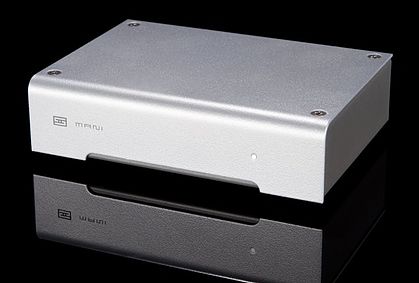
American outfit, Schiit, has released a new budget phono amp, Paul Rigby reviews the Mani
OK, I’ll pause a second while you think of 101 additional different jokes surrounding the name, which is apparently German and pronounced ‘Shih-tah’.
Aimed squarely at the budget or entry-level user looking to investigate this new fangled format called vinyl, the Mani is a basic and easy to use phono amp that, although designed and built (not just assembled) in the USA, arrives with a Chinese-made wall wart power supply.
Spanning 127x89x318mm and weighing in at 450g, the solidly constructed, silver coloured miniature amplifier supports MM and, admirably, MC cartridges (although load options are few).
The Mani provides four switchable gain modes, accessible via a small cluster of fiddly DIP switches, situated under the chassis: 30db, 42db, 47db and 59dB.
The front of the box is a simple affair that is dominated by a blindingly bright power light while the rear provides the usual phono amplifier connections and a toggle power switch plus grounding point and access socket for the wall wart power supply.
SOUND QUALITY
At this price point, most users will tote a MM-based turntable but I did briefly test it with my Benz Glider MC while spinning a slice of prog rock and Yes’ Yours Is No Disgrace. Despite a relative lack of dynamic extension and upper midrange insight, the Benz offered an admirably ordered soundstage and bass definition.
Switching to more realistic testing conditions and the Rega RP3/Elsys2 MM, it was noticeable how relatively high the gain was on the Schiit compared to my reference Cambridge. Popping the volume down a touch, I was able to enjoy the open and airy midrange which added distinct length on the treble tails during cymbal strikes. This was helped by the welcome instrumental separation, possibly a result of reduced noise during the design, as seen in our tests. Certainly, the vocals from Jon Anderson were smooth and the accompanied vocal harmonies were sweet and easy on the ear.
The Schiit could also get down and dirty and, again supported by our tests, the phono amp was able to squeeze extra bass from the tiny Roth speaker cabinets giving the Chris Squire bass a more meaty, emboldened bite while the acoustic guitar strums from Steve Howe had an open, rather exposed, string effect. That is, the guitar sounded more like a group of strings being strummed than one tone being produced en masse.
Moving to Mars, the Bringer of War from Holst’s The Planets, it was evident just how scratchy those introductory strings were, adding more portent to the oncoming onslaught, while the following, strong string effect managed to retain a smooth presentation, despite the impact of its entrance.
The enhanced separation added complexity and depth to the soundstage also helped to control the brass in the upper mid region, reducing listening fatigue.
Users who purchase an introductory budget system often have one eye on the upgrade path further down the line so, with this in mind, I installed a pair of the newly introduced Q Acoustics 3020 stand mounted speakers (£190) which would, in fact, be part of an ideal upgrade path for this very system. The Mani could relax a tad with these speakers because they were easier to run, it also allowed me to lower the volume on the amplifier which helped to de-stress the presentation a touch.
Running Holst through this new pair of transducers showed that the introductory string scratches were almost insect-like in their progress producing involuntary itching from this reviewer. Similarly, the clarity and transparency of brass within the upper mids was impressive as was the bass response.CONCLUSION
Despite the glaring power light that threatens to burn any passing retina (a piece of tape should be used to cover the offending article), this compact and easy to use phono amp offers good value for money and excellent sound quality, for the price. Also, the Q Acoustics speaker test shows that there is plenty of good music to be squeezed from the Mani which bodes well for its inclusion as part of a system targeted for future upgrades.
SCHIIT MANI
Price: £120
Website: www.electromod.co.uk
Tel: 01494 956558
Good: overall sound quality, ease of use, compact
Bad: power light
RATING: 8
SYSTEM USED
Avid Acutus turntable, SME IV arm, Benz Glider MC cartridge
Rega RP3 turntable, RB303 arm & Elys2 MM cartridge
Cambridge 540P Phono Amplifier (MM)
Trichord Dino phono amp (MC)
Cambridge Azur 651A Integrated Amplifier
Roth OLi RA1 speakers
Q Acoustics 3020 Speakers & Q Acoustics Stands
Black Rhodium Twist Speaker Cables
Tellurium Q interconnects

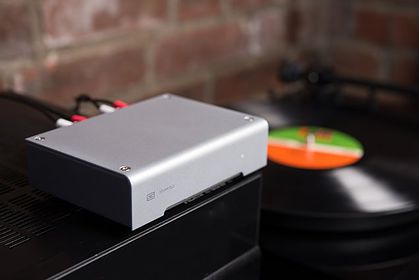
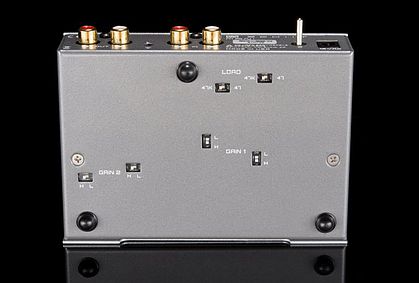
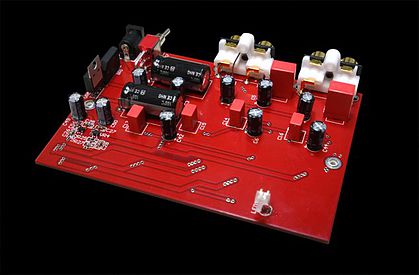
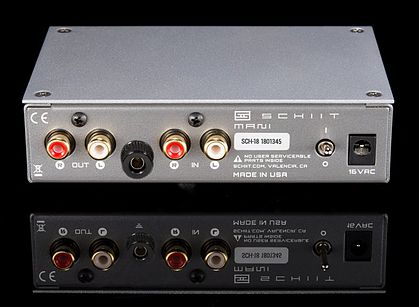
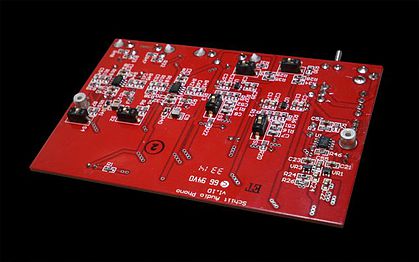
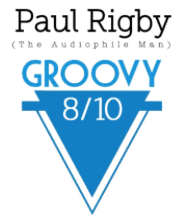


How does the Mani compare to the Rega Fono MK3? Im leaning towards the MK3 despite being more than double in cost.
Hi Sim – well, you’d expect the Mani to be better if you looked at the difference in price and it’s the Mani I would go for. Both are excellent though.
Hello Paul, I recently bought a Schitt and Lounge Audio MK3 just for fun. I am using the MH Ikura and 2M blue cartridge and so far I think I like the Schitt better. Vocals like from Adele are so clean and clear compared to the Lounge. While sound is subjective, Is it possible that the Schiit is really that much better then the Lounge that costs $322 shipped? Have you had the opportunity to listen to a Lounge?
Hi Ariel – I think you’ve already answered the question 🙂 Trust your ears and go with them. They’re the most important measuring equipment you all ever have. I’ve yet to hear the Lounge but, really, if you love the Schiit then it doesn’t really matter.
Hi Paul, thanks for your review. It looks like you have a Trichord dino Phono stage in your set up. Do you use this also with mm cartridges? My question really is have you compared it with the Shiit mani and if so, which one sounds best? I would like to upgrade from my current Rega fono mini A2D and wonder whether the Shiit mani will be an improvement or do I have to aim higher? If so should I get the Trichord dino (without the upgraded power supply) or the Arcam rphono? Or any other suggestions? I am using mm cart on an Edwards audio turntable. Focal aria speakers. Thanks
Hi Anna – The Dino sounds better but it’s also way more expensive. So it should 🙂 I would certainly aim higher to received an appreciable improvement. Can I ask if you have a budget figure?
Thanks for your reply Paul, well my budget is somewhere between ¬£300-¬£600. The higher figure would be if there was a really really good one that could warrant such a lot of money. It seems wrong to spend more on a Phono stage than what I paid for the whole turntable including tonearm and cartridge… what’s the best I can get in your opinion?
Hi Anna – I take your point but please remember what a Phono amp does. It’s a really specialised bit of kit. This is the thing that takes that tiny, tiny signal that comes from your turntable’s stylus, and amplifies it enough for your main amp to then take over. Your main amp can’t cope with the task – it’s too much to handle for it. The Phono amp is thus a critical part of the turntable, in effect. It’s part of the turntable jigsaw. Without it, the music stays stuck at the point of the stylus. The phono amplifier is often unjustly under-estimated. Spending serious money on this box is money well spent. That said, I appreciate you’re on a budget, so I’d go for this little box, an excellent product offering very high value for money: https://theaudiophileman.com/110-phono-amplifier-review-moon/
TY for the write up! I am running an rp3 through a Mani as well. It seems as though my setup has lost some punch and separation after an upgrade from AT LP60. I was curious as to what gain settings you found most flattering for the Elys2 cart. Love to hear your thoughts on this!
Hi John – if there’s one thing I’ve learned it’s to take recommended gain settings as nothing more than that…recommended. What I would advise you to do is to go through them, one at a time. Zero the volume before each change in case of wild gain changes. Then up the volume gradually, listen to a test recording of your choice and see what you think. Reviews, as it where, each setting. See which one grabs you, which one fits your ears. You may find the best one is not ‘recommended’ at all! 🙂 That’s happened to me on several occasions. That’s what I do with every phono amp I get in for review now. Works every time.
Great article, love your work. Could you review Mofi Studiophono ? Maybe even Studiophono vs Schiit Mani (also if you already tried Tisbury Audio Domino) ?
Hi Bulgar – very nice of you, thank you. I did request a heap of MoFi stuff and they agreed to send but nothing ever arrived. And I’m not sure why. I need to try again obviously. Same with Tisbury, oddly enough. It may be that people forget and I forget to remind them and…life stuff. I’ll put them on my ‘to do’ list.
Hello Paul. I wondered if you could give me an advice on a phono between the Mani and Rega Fono mini A2D for my Rega Planar 3 (2016). As I live in Thailand, the Rega Fono Mini is available at around $170, but there are no Mani around here. Therefore, if I were to get a Mani, I’ll have it shipped from the UK, which would cost me around $200. The price difference is not that big. But I only have one shot for a phono. Your advice would be much appreciated.
In that case, grab a Fono, Patt. It’s on your door step, it’s in one piece, you have a return route if required, etc. Go for that.
Thank you so much, Paul. Please keep up your good work. I’m very new to the vinyl world, but have really enjoyed reading your work.
That’s very nice of you, Patt. Thanks for reading!
Hi Paul,
I have a pair of Sennheiser HD700, Schiit Vali headphone amp currently paired with Schiit Modi DAC connected to my laptop and am planning to buy my first turntable (still not decided but it will be either of the Rega Planar 1, 2 or 3).
Do you think the Schiit Mani would be a good phono to use with the headphone amp? The main reason I’m considearing it is that it will be aesthetically pleasing stacked with the Vali (as my current Modi/Vali setup is) but am not sure about the sound.
Hi Pawel – the Mani should work well with any of the Rega turntable you list there.
Hi Paul, I am in the market for a phono stage and would like your advice as you have reviewed my narrowed down list. My current set-up is a Rega RP6 turntable (new model) with the Exact MM cartridge, Audiolab 6000A amp and Dali Zensor 5 speakers. I am currently using the Audiolab amps internal phono stage which sounds good to my ear, however I would like to try and improve things further to get the best out of the RP6. The phono stage option I have opted for are either the Schiit Mani or the more expensive, Moon LP110 V2. I know the Moon will be the best option but I would like your opinion on where the Schiit Mani sits on a scale between the Audiolab internal phono stage and the Moon LP110 V2. For example, if the Schiit Mani is closer to the Moon I would probably go the Schiit and save some cash but if the Schiit is closer to the Audiolab then the Moon is my best option. Any advice you could give is appreciated.
Hi Neil – the built-in phono amp is fine but you’re wise to think external. The Mani is a great budget design, highly recommended. The Moon is about two rungs up the ladder from that. Both are great performers but the Moon offers better quality.
Hi Paul,
May I suggest that, if you haven’t already done so, you arrange to check out the latest Mani 2, which (in my system detailed below) is a huge all-round improvement on the old Mani 1 upon which you favourably reported above. There aren’t too many reviews of it yet, but one individual who recently heard the revised version labelled it “fantastic”. I agree; it’s a ¬£146 (delivered) bargain. In addition it was received in Northern England from the manufacturer in Texas, USA via FedEx in less than 3 days after ordering, and in my view deserves a hearing.
Regards, John.
Rega P3 (2021) improved/Goldring G1042/Mani 2/Marantz NR1711/Wharfedale Evo 4.2/Mogami 3082 cabling
Thanks John.